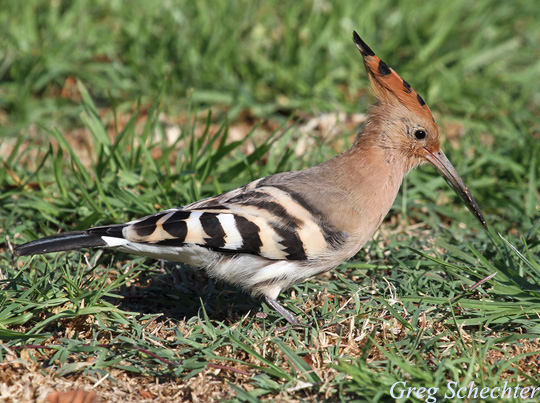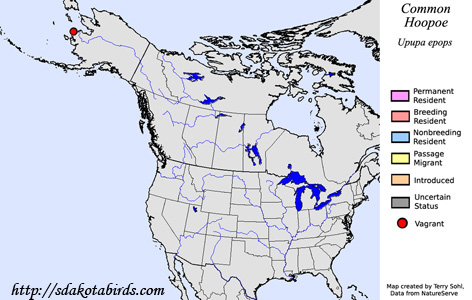| Length: 12 inches | Wingspan: 18 inches | Seasonality: Non-resident in South Dakota |
| ID Keys: Prominent crest; long downcurved bill; pinkish-brown plumage on head, breast, and back; dark and light barred wings; long tail | ||
 The
Eurasian Hoopoe is a bird of the Old World, with a range that covers much of
Europe, southern Asia, and parts of Africa. In North America, they are
extremely rare vagrants. At the time of this writing, there was one known
sighting in the Yukon Delta of Alaska in 1975. The species is named
for their far-carrying song.
The
Eurasian Hoopoe is a bird of the Old World, with a range that covers much of
Europe, southern Asia, and parts of Africa. In North America, they are
extremely rare vagrants. At the time of this writing, there was one known
sighting in the Yukon Delta of Alaska in 1975. The species is named
for their far-carrying song.
Habitat: Found in a variety of open settings, Eurasian Hoopoe are often seen around human habitation, such as in parks, suburban settings, orchards, and vineyards. In general, in their range they are found where open spaces are available for foraging, and cavities are available for nesting.
Diet: Feeds on insects, spiders, snails, and other small invertebrates. Opportunistic, they will also take small vertebrates such as small lizards, snakes, and small rodents. They will also sometimes feed on seeds and berries.
Behavior: Foraging is primarily down on the ground, gleaning insects from vegetation or the ground, or using its long bill to probe under the surface. Despite the large size and long bill, they also can be adept at capturing insects in mid-air.
Nesting: The nest of a Eurasian Hoopoe is in a cavity, often an old woodpecker hole or other tree cavity, but they will also use cavities in man-made structures. The nest is typically lined with soft materials such as feathers and plant fibers. The female lays anywhere between 3 and 11 eggs. She alone incubates the eggs, but both parents help tend to and feed the young after they hatch. They typically produce 2 or 3 broods per breeding season.
Song: A rich, soft (but far-carrying) hoo-hoo-hoo.
Migration: Eurasian Hoopoe are considered permanent residents in some warmer parts of their range, such as those found in Africa. Other populations are migratory, moving to more tropical locations for the winter.
Interactive eBird map: Click here to access an interactive eBird map of Eurasian Hoopoe sightings
Similar Species: For any vagrants that happen to be found in North America, the Eurasian Hoopoe would be very distinctive and easily identified.
Conservation Status: Populations appear to be stable, they are found across an extremely large geographic area, and there are no major conservation concerns. The IUCN lists the Eurasian Hoopoe as a species of "Least Concern".
Further Information: 1) Birdlife International - Eurasian Hoopoe
2) Handbook of the Birds of the World - Eurasian Hoopoe
3) British Garden Birds - Eurasian Hoopoe
Photo Information: Photo by Greg Schechter - November 14th, 2011 - Tel Aviv, Israel - Photo licensed under Creative Commons Attribution 2.0 Generic license
| Click below for a higher-resolution map |
 |
| South Dakota Status: Non-resident in South Dakota |
Additional Eurasian Hoopoe Photos (coming soon!!)
